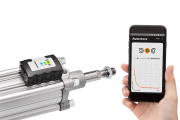Pneumatics systems are flexible and easy to integrate into your application, allowing you to optimise system performance while saving engineering time. Below are ten tips from Emerson that will help you to engineer an optimal pneumatic solution for your application.
-
Select the optimal cylinder and tubing diameter.
 The right cylinder and tubing dimensions play an important role when it comes to energy efficiency. If it is too large you waste air, and if it is too small you may not have enough power to drive your machine. During the design stage of your pneumatic system, selecting the optimal cylinder and tubing diameter, along with the right compressed air solution, is important. Emerson provides two tools that help in selection. The first is an online air consumption calculator, the second a cylinder finder. The cylinder finder enables you to enter basic data about your application, after which you are presented with the cylinder options that best meet your requirements.
The right cylinder and tubing dimensions play an important role when it comes to energy efficiency. If it is too large you waste air, and if it is too small you may not have enough power to drive your machine. During the design stage of your pneumatic system, selecting the optimal cylinder and tubing diameter, along with the right compressed air solution, is important. Emerson provides two tools that help in selection. The first is an online air consumption calculator, the second a cylinder finder. The cylinder finder enables you to enter basic data about your application, after which you are presented with the cylinder options that best meet your requirements.
-
Online tools provide added value.
You can customise your pneumatic component packages easily through online tools, such as product configurators. These enable engineers to choose the functions their application requires and to see suggested solution packages that fit their needs. Full product data is available immediately, including CAD models, prices, and delivery times. Emerson offers configurators for its wide variety of AVENTICS™ pneumatic products, including configurators for cylinders, valve systems and air preparation units.
-
Mount valves on the cylinder.
When cylinders are located remotely or at a distance from air supply, long tubing lengths, multiple tubing connections, and long returns may cause a loss of compressed air at the valves. By mounting valves directly to the cylinder, these losses are eliminated. Additionally, this decentralisation of compressed air shortens cylinder response times.
-
Determine your filter needs.
 Your filter needs become very important for several reasons. A filter that is too fine will decrease compressed air flow, which leads to energy losses. A filter that is too coarse results in faster wear to the pneumatic components caused by larger particles getting into the system. By focusing on a needs-based filtration system, both of these challenges can be overcome easily.
Your filter needs become very important for several reasons. A filter that is too fine will decrease compressed air flow, which leads to energy losses. A filter that is too coarse results in faster wear to the pneumatic components caused by larger particles getting into the system. By focusing on a needs-based filtration system, both of these challenges can be overcome easily.
-
Create combination valve systems when possible.
Many pneumatic solutions are designed to integrate multiple single valves. This increases the time and cost of installation. By combining these single valves into valve systems, engineers can reduce their assembly efforts drastically.
-
Provide appropriate feedback to your system.
Valve systems communicate through multipole, standard fieldbus systems or Ethernet connections to intelligent machine controls. By incorporating appropriate feedback of all diagnostic and sensor data, the system is able to expand machine function and reduce maintenance and service requirements.
An example is the Series G3 electronic platform from Emerson, which as an integrated graphic display. It is using plain-language messaging to provide clear diagnostic information and version tracking. A visual status and alarm indication are in a clearly visible display area at one end of each module.
-
Provide only demand-based air pressure.
Machines are unable to reach optimal performance if they have insufficient air pressure available. Excessive air pressure wastes energy. Therefore, by incorporating manual or electro-pneumatic pressure regulators, engineers can assure optimal pressure is always present.
-
Provide the right level of cushioning in cylinders.
 By providing the perfect level of adjusted cushioning for each cylinder, engineers are able to reduce system costs while extending service life. Engineers can also select smaller cylinders and shorten cycle times, which also reduces noise levels.
By providing the perfect level of adjusted cushioning for each cylinder, engineers are able to reduce system costs while extending service life. Engineers can also select smaller cylinders and shorten cycle times, which also reduces noise levels.
With the AVENTICS Cushioning Adjustment Tool you can easily adjust the cushioning of your cylinder via the app on your mobile phone.
-
Provide ultimate system safety.
Pneumatic components are offered in a wide variety of solutions in line with multiple safety standards, including for explosive environments. The latest information about these products is always available online.
Emerson’s zoned safety approach enables you to create safe manufacturing environments without compromising productivity. Download the free white paper to learn how this works.
-
Ask the experts.
Users who are not typically involved in laying out and integrating pneumatic systems often have a lot of questions. It’s important to note that companies that have been in the pneumatic systems industry for a long time also have in-house engineering teams with the expertise you may need. Emerson has many pneumatic system experts available for consultation. These engineers are familiar with the latest products and technologies and have worked on thousands of systems. They can bring to bear expertise that has been gained across multiple industries and many applications. Often a short conversation can save you time and help you achieve optimal results. Consult an Emerson Expert directly.

